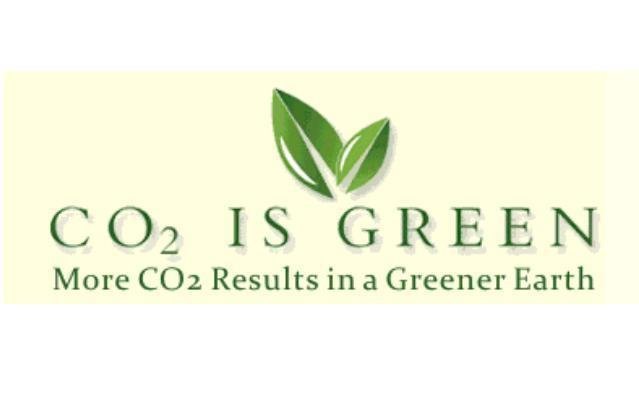
An article in today's Washington Post reports "New Groups Revive the Debate Over Causes of Climate Change." We are told that a "fractious debate" is brewing! We are further informed that "assumptions are being challenged!" All of that is true. What the article fails to report is that on one side of this debate are lying energy industry shills, which means that these "assumptions" are being "challenged" by people operating in bad faith.
All of this comes under the heading of the Washington Post's "Green: News About The Environment" banner, which would lead one to believe that it's a source that would strive to actually inform readers, instead of badly misinform them. In this case, they carry a brief for an outfit called "CO2 Is Green," whose P.R. strategy is based in playing people for fools by means of the promotion of reductive reasoning and oversimplification. Their central premise is basically: "But human beings breathe out carbon dioxide, so it must be good to produce even more of it!" Normally when one hears this sort of statement being made, one pauses to make sure it's not being made by a seven-year-old child. If it is, it can be forgiven, because one day, God willing, said child will grow up to obtain what is colloquially known as a "high school education."
When this idea is promulgated by adults, however, it requires an adult to dispense some reality-based facts. Since the Washington Post is more concerned with the whole "who's up and who's down" politics of the matter, and cannot be bothered with actual information, I shall take up the cause.
CO2 is Green, right on their webpage, happily inform visitors that "Humans inhale and exhale CO2 with every breath. How could anyone expect you to believe it is a human health hazard?" Well, in the first place, this sort of ignores the fact that human beings exhale CO2 for a reason. If you want to appreciate how CO2 becomes a health hazard, you really ought to try inhaling pure CO2 for a period of time. See, there's this whole thing called the Krebs Cycle by which oxygen is converted into adenosine triphosphate, which helps to form the building blocks of proteins and amino acids and allow for the replication of human DNA, all of which allows the human being to...how should I put this? "Live." Breathing in pure CO2 would not allow any of this to occur, which would eventually lead to the state of "not living."
But more to the point. Yes, human beings produce carbon dioxide and then plants, through photosynthesis, metabolize this exhaust and convert it back into oxygen. All of this is part of a naturally occurring cycle that functions well when it's in equilibrium. But what the good folks at CO2 Is Green -- fronted by "a veteran oil industry executive" and supported by the "chief executive of and leading shareholder in Natural Resource Partners, a Houston-based owner of coal resources that lets other companies mine in return for royalties" -- want you to believe is that when the fossil fuels they shill for are burned, it's just as easy and natural as respiration. It's like breathing, only lots lots more of it!
But the carbon captured in fossil fuels is not a part of the naturally occurring process of respiration. That carbon is the result of centuries of organic decay. Left on its own, it would take millions of years for fossil fuels to "exhale" their carbon dioxide. When fossil fuels are burned, however, it's released into the atmosphere on a much shorter timeframe of a few centuries, thus increasing the amount of carbon dioxide in the environment. That throws off the equilibrium established between respiration and photosynthesis. This is where the whole concept of "carbon offsets" come from as a means of restoring this healthy equilibrium.
Another important part of this equilibrium is the ocean, which acts as a natural "sink," or storage place for carbon. However, humans have so quickly and vastly increased the amount of CO2 in the atmosphere in the last 150 years, the ocean is losing its ability to absorb this CO2. In 1960, a metric ton of CO2 released into the air would result in about 400 Kg of it remaining in the atmosphere; in 2006, about 450 Kg remain because of the ocean's decreased ability to absorb it. If we continue to pump increasing amounts into the air, this trend will only continue, meaning more and more of all greenhouse gases released will remain in the atmosphere.
CO2 is Green also makes a blanket claim that "lowering levels of carbon dioxide would actually inhibit plant growth and food production," the idea being that we should burn fossil fuels like crazy to increase vegetation and plant life. This is what is known as a "gross oversimplification." In the first place, plants require more than just carbon dioxide to thrive. They need water and nitrogen. Plants in different climates need varying amounts of these ingredients to thrive. Many forms of plant life have biological mechanisms that regulate their intake of CO2, making an increase in its level irrelevant. Air pollution also contributes to an increased amount of ground level ozone, which inhibit plant growth. Increases in CO2 also lead to the acidification of oceans, which inhibit the growth of phytoplankton, which inhibits the development of marine plant life.
Because CO2 in the atmosphere traps heat, warming the earth's atmosphere, many plants are also now suffering the negative consequences of this warming. Higher winter temperatures have allowed pests to survive at increasingly northern latitudes, subjecting more and more crops to increased pest stress. Forest fires are also becoming more frequent as hot, dry weather becomes the norm. Scientists have overwhelmingly concluded that the negative impacts of climate change to forestry and agriculture will FAR outweigh any small positive consequences of increased levels of CO2.
CO2 Is Green also sort of glosses over the point that if you want more plants to grow, you have to let that happen. If they want to promote more plant life, they'd get there a lot faster by simply supporting sustainable forestation.
And so, you see, one whole side of this great debate thrives only because the reporters hired to write for an environmental section of a newspaper cannot be bothered to learn even the basic facts of their topic area. What the Washington Post has essentially done here is place nonsense on the same footing as science. It's as if they've taken up the flat-earth cause. Now, is there a time and a place to debate whether the earth is flat? Sure! That time and place, however, was in the goddamn 12th century, not a major American newspaper circa 2009.
[Would you like to follow me on Twitter? Because why not? Also, please send tips to tv@huffingtonpost.com -- learn more about our media monitoring project here.]
